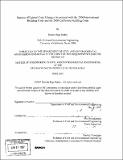Impacts of lateral code changes associated with the 2006 International Building Code and the 2008 California Building Code
Author(s)
Ratley, Desirée Page
DownloadFull printable version (10.90Mb)
Other Contributors
Massachusetts Institute of Technology. Dept. of Civil and Environmental Engineering.
Advisor
Oral Buyukozturk.
Terms of use
Metadata
Show full item recordAbstract
The 2008 California Building Code (CBC) will adopt the structural section of the 2006 International Building Code (IBC), which includes alterations to the procedure to determine earthquake design loading, and a drastic move to a complicated method to determine design wind pressures. The implementation of the revised 2006 International Building Code, and the subsequent California adoption of the structural section will have significant effects on the design and construction of structures not only in California, but also the rest of the country. Through a comparison of the design of a steel moment-resisting frame low-rise structure, it was determined that the new code will result in design values that differ from those resulting from the previous codes. In order to compare the relevant codes in different areas of the country, this thesis considers three design scenarios for the low-rise structure: seismic loading in Southern California to compare the 2001 CBC, the 2003 and the 2006 IBC, seismic loading in the Midwest to compare the 2003 IBC and the 2006 IBC, and wind loading in Northern California to compare the 2001 CBC and the 2006 IBC. (cont.) In the first case, the change from the 2001 CBC to the 2003 IBC was an 8 percent increase in base shear, but a 2 percent decrease from the 2001 CBC to the 2006 IBC. The second case resulted in a 29 percent increase in base shear from the 2003 IBC to the 2006 IBC. The result of the third case was design wind pressures that decreased 20 percent from the 2001 CBC to the 2006 IBC. These design differences will change the design of the lateral force resisting system, especially the later two cases. In addition, the design engineers in California will have to learn a new, greatly more complicated method to design for wind loading. These combined effects of the code changes will impact both engineers and the resulting building designs in all parts of the country.
Description
Thesis (M. Eng.)--Massachusetts Institute of Technology, Dept. of Civil and Environmental Engineering, 2007. Includes bibliographical references (leaves 94-96).
Date issued
2007Department
Massachusetts Institute of Technology. Department of Civil and Environmental EngineeringPublisher
Massachusetts Institute of Technology
Keywords
Civil and Environmental Engineering.